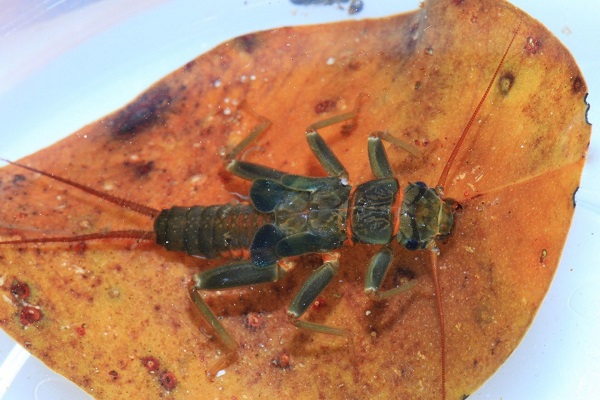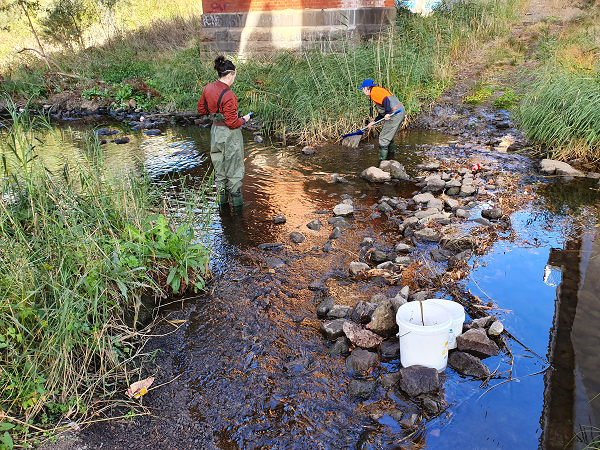Aquatic macroinvertebrates, commonly called waterbugs, are a very diverse group of creatures. There are lots of different types, some look very similar to each other while others look completely different. Some common examples include: dragon fly larvae, mosquito larvae, insects, worms, crustaceans and snails.

Stonefly, by Parks Victoria.
Did you know?
- Aquatic means water, macro means you can see it with your eye and invertebrate means without a backbone.
These little waterbugs are busy! They spend a lot of their time eating dead or decaying organic matter in the water, such as fallen leaves, twigs and other plant material. Other macroinvertebrates prefer scraping algae off the surface of water plants or rocks.
These small critters are a key part of the water ecosystem. Not only are they busy keeping the waterways clean by consuming organic matter they are also a highly sought out food source for numerous native fish species, colonial birds, waterbirds and of course our iconic platypuses.
Aquatic macroinvertebrates are a great indicator of water quality. Because of their varying degrees of pollution sensitivity, they can help waterway managers understand the health of a river, stream or wetland. A healthy waterway will support a certain range of macroinvertebrate whereas a polluted waterway will likely support different types. For example, stoneflies (shown in the photo above), mayflies and caddisflies enjoy clean rivers and streams as they are very sensitive to pollution, if found they would likely indicate that the river is healthy.
Leeches, aquatic worms and black flies can thrive in highly polluted waterways and are therefore, highly tolerant to pollution. If you found that these types of macroinvertebrates in large numbers, and few other waterbugs, the waterway may be quite polluted.
By undertaking macroinvertebrate surveys along the length of a stream, sections that are more polluted than others can be identified, this can then help determine the source of the pollution and can support actions to improve water quality.
Up to 50 citizen scientists have been working with a team of researchers to collect water samples and identify macroinvertebrates from 13 sites along the Werribee River, as part of a project to uncover how pollution in the river is impacting on the ecosystems.

Monitoring waterbugs in the Werribee River, by Werribee River Association
How environmental flows support aquatic macroinvertebrates?
- Environmental flows enhance habitat for macroinvertebrates by flushing silt from rocky sections of the river, allowing the waterbugs to access nooks and crannies where they can feed, breed and hide from predators.
- Water for the environment can inundate sections of the river and wetlands increasing the amount of habitat and food macroinvertebrates can access.
- Water deliveries flush pools helping to improve water quality and in turn enhancing habitat and feeding opportunities for waterbugs.
To find out how water for the environment is being used to support waterbugs where you live, go to https://www.vewh.vic.gov.au/rivers-and-wetlands and click on the link for your local waterway, then look for watering actions with this symbol:
![]()
Currently the Victorian Government is directing all Victorians to stay at home, restricting sporting, cultural, recreational and commercial activities to help limit the spread of coronavirus (COVID-19).
However, once these restrictions are lifted and if you are keen to get out and go looking for aquatic macroinvertebrates you won’t have to go too far as they are found in most freshwater environments including rivers, creeks, dams, wetlands, swamps and billabongs. They can be found in slow moving pools or in flowing streams and typically set up home on or under bits of woods, rocks or amongst water plants. Maybe you have a stream in your backyard that you could poke around in, or one close by in a secluded spot. A great starting point would be to jump online and have a look at which rivers flow near your house or in your local neighbourhood.
To find out more head to: Waterwatch and Melbourne Water waterbug census.